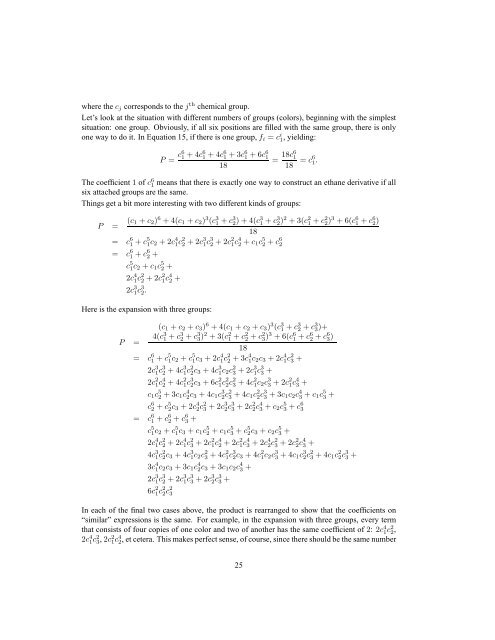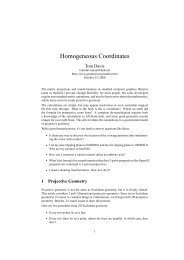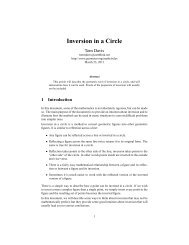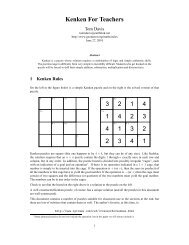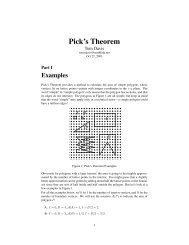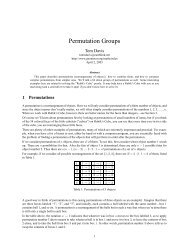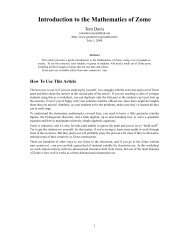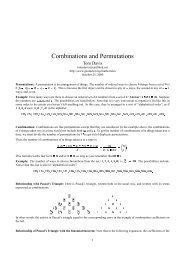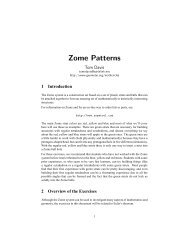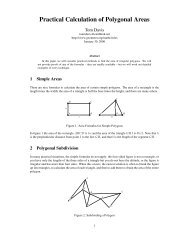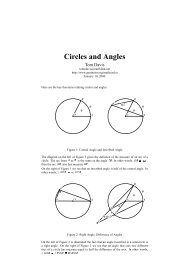P´olya's Counting Theory - Home Page -- Tom Davis
P´olya's Counting Theory - Home Page -- Tom Davis
P´olya's Counting Theory - Home Page -- Tom Davis
Create successful ePaper yourself
Turn your PDF publications into a flip-book with our unique Google optimized e-Paper software.
where the c j corresponds to the j th chemical group.<br />
Let’s look at the situation with different numbers of groups (colors), beginning with the simplest<br />
situation: one group. Obviously, if all six positions are filled with the same group, there is only<br />
one way to do it. In Equation 15, if there is one group, f i = c i 1, yielding:<br />
P = c6 1 + 4c6 1 + 4c6 1 + 3c6 1 + 6c6 1<br />
18<br />
= 18c6 1<br />
18 = c6 1 .<br />
The coefficient 1 of c 6 1 means that there is exactly one way to construct an ethane derivative if all<br />
six attached groups are the same.<br />
Things get a bit more interesting with two different kinds of groups:<br />
P = (c 1 + c 2 ) 6 + 4(c 1 + c 2 ) 3 (c 3 1 + c3 2 ) + 4(c3 1 + c3 2 )2 + 3(c 2 1 + c2 2 )3 + 6(c 6 1 + c6 2 )<br />
18<br />
= c 6 1 + c5 1 c 2 + 2c 4 1 c2 2 + 2c3 1 c3 2 + 2c2 1 c4 2 + c 1c 5 2 + c6 2<br />
= c 6 1 + c6 2 +<br />
c 5 1c 2 + c 1 c 5 2 +<br />
2c 4 1 c2 2 + 2c2 1 c4 2 +<br />
2c 3 1c 3 2.<br />
Here is the expansion with three groups:<br />
P =<br />
(c 1 + c 2 + c 3 ) 6 + 4(c 1 + c 2 + c 3 ) 3 (c 3 1 + c 3 2 + c 3 3)+<br />
4(c 3 1 + c3 2 + c3 3 )2 + 3(c 2 1 + c2 2 + c2 3 )3 + 6(c 6 1 + c6 2 + c6 3 )<br />
18<br />
= c 6 1 + c 5 1c 2 + c 5 1c 3 + 2c 4 1c 2 2 + 3c 4 1c 2 c 3 + 2c 4 1c 2 3 +<br />
2c 3 1 c3 2 + 4c3 1 c2 2 c 3 + 4c 3 1 c 2c 2 3 + 2c3 1 c3 3 +<br />
2c 2 1c 4 2 + 4c 2 1c 3 2c 3 + 6c 2 1c 2 2c 2 3 + 4c 2 1c 2 c 3 3 + 2c 2 1c 4 3 +<br />
c 1 c 5 2 + 3c 1c 4 2 c 3 + 4c 1 c 3 2 c2 3 + 4c 1c 2 2 c3 3 + 3c 1c 2 c 4 3 + c 1c 5 3 +<br />
c 6 2 + c 5 2c 3 + 2c 4 2c 2 3 + 2c 3 2c 3 3 + 2c 2 2c 4 3 + c 2 c 5 3 + c 6 3<br />
= c 6 1 + c6 2 + c6 3 +<br />
c 5 1c 2 + c 5 1c 3 + c 1 c 5 2 + c 1 c 5 3 + c 5 2c 3 + c 2 c 5 3 +<br />
2c 4 1 c2 2 + 2c4 1 c2 3 + 2c2 1 c4 2 + 2c2 1 c4 3 + 2c4 2 c2 3 + 2c2 2 c4 3 +<br />
4c 3 1c 2 2c 3 + 4c 3 1c 2 c 2 3 + 4c 2 1c 3 2c 3 + 4c 2 1c 2 c 3 3 + 4c 1 c 3 2c 2 3 + 4c 1 c 2 2c 3 3 +<br />
3c 4 1 c 2c 3 + 3c 1 c 4 2 c 3 + 3c 1 c 2 c 4 3 +<br />
2c 3 1 c3 2 + 2c3 1 c3 3 + 2c3 2 c3 3 +<br />
6c 2 1c 2 2c 2 3<br />
In each of the final two cases above, the product is rearranged to show that the coefficients on<br />
“similar” expressions is the same. For example, in the expansion with three groups, every term<br />
that consists of four copies of one color and two of another has the same coefficient of 2: 2c 4 1 c2 2 ,<br />
2c 4 1c 2 3, 2c 2 1c 4 2, et cetera. This makes perfect sense, of course, since there should be the same number<br />
25


